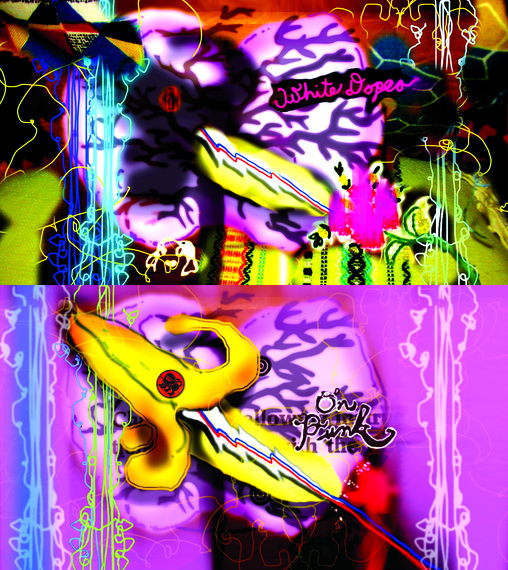This is part 2 of my interview with Lev Manovich, author of the new book Software Takes Command; part 1 can be read here.
Still from Jeremy Blake's digital animation, Sodium Fox (2005), courtesy Kinz Fine Art
These media, being extensions of ourselves, also depend upon us for their interplay and their evolution. The fact that they do interact and spawn new progeny has been a source of wonder over the ages. It need baffle us no longer if we trouble to scrutinize their action. We can, if we choose, think things out before we put them out.
Marshall McLuhan, Understanding Media (1964)
Indeed, if after the death of God (Nietzsche), the end of grand Narratives of Enlightenment (Lyotard) and the arrival of the Web (Tim Berners-Lee) the world appears to us as an endless and unstructured collection of images, texts, and other data records, it is only appropriate that we will be moved to model it as a database. But it is also appropriate that we would want to develops poetics, aesthetics, and ethics of this database.
Lev Manovich, "Database as Symbolic Form" (1998)
Unsuprisingly, given Manovich's stated desire to avoid generalizations about technology, Software Takes Command is most successful when offering a detailed analysis of specific media software. Using the motion graphics application After Effects as an example, Manovich explores "hybridity," a concept first put forth by McLuhan. He suggests that rather than attempt to "divide the extremely diverse media species of software culture into a small number of categories (i.e. mediums), we adopt "a model of multiple species related via evolutionary development that we can borrow from biology....The key advantages of this 'species model' over a medium model (for analysis) are their large numbers..., their genetic links... and the concept of evolution..."
Manovich distinguishes between remix practice, or "multimedia" which combines content from discrete media and "deep remix" which takes advantage of the compatibility between files generated by different programs to remix the techniques of individual media such as painting, collage, and animation.
Takeshi Murata's Pink Dot, an example of "deep remix"
Szilak: You differentiate between the typical mashup, a form of multimedia, and what you call "successful artistic hybrids" such as Takeshi Murata's Pink Dot, and Joachim Sauter's The Invisible Shape of Things Past which "increases the representational and aesthetic value" offered by each media type used. Moreover, you suggest "choosing from the same set of web sources and data sources available to everybody else may not be the right solution." I wonder, however, if you think failure, meagerness, smallness can be a viable aesthetic, one that resists the totalizing tendency of After Effects, and points out and critiques this hegemony? (Glitch aesthetics is one possible take on this, but perhaps there are others?)
Manovich:
Given this variety, I don't want to use words like "hegemony" in relation to After Effects or other media software. So when I analyze certain tendencies such as ""constant change on many visual dimensions," I am not saying that they dominate (the way for example particular ways of editing and structuring narratives were dominating mid 20th century Hollywood cinema). Rather, I was trying to find any "islands" of coherence in the "sea" of endless variety, so this feature is one of them.Szilak: Perhaps "hegemonic" is not the right word, but most people do not code, thus, they use the software available, which, as you point out, promotes certain kinds of aesthetics. In the "variable form" section, you noted that "we can connect this preference for constant change to the particulars of software used in media design" Can you say something more about this, specifically commenting on how some art, such as glitch, purposefully avoids the seamless, convergent aesthetics promoted by software, and the relevance of this?
Manovich: I don't want to make an argument that "(some) artists subvert / resist the dominant cultural / visual forms in software culture." Interesting things with software are done by programmers, designers, big and small companies and not just by artists. Also, today most talented digital artists are working in big companies (for example, Aaron Koblin and all top people in data visualization.)
Software allows us to invent new forms of vision, memory, communication and knowledge making, Google (from search to Street View and Google Earth) is more avant-garde than any artist. I proposed this a long time in my article "Avant-Garde as Software," (1999), and I continue to support this. This is one of the key things about software and networks - we no longer are limited to subverting/ making fun of/critiquing within the limited and isolated art world realm (like media art of the 20th century). Instead, we can create alternative systems, which can really affect society and be used by (the) masses. So putting code on GitHub is progressive. Making "glitch art" shown in galleries is not.
Manovich, himself an artist working primarily with database, cinema and software, does a good job of "illustrating" his arguments with examples of individual artworks that successfully use hybrid visual language. Given his preference for hybrid over multimedia work, it surprised me that he praised artist Jeremy Blake whose visual aesthetic can be read as "an implicit statement against the popular idea of 'convergence'."
Jeremy Blake's Chemical Sundown (2001), courtesy Kinz Fine Art
Szilak: You point out that although in Blake's films "different media have become compatible, this does not mean their distinct identities have collapsed." What is the importance, if any, of recognizing the distinct identities of media? Are there certain media--I am thinking especially of text here--which resist integration more than others?Manovich: I think the importance is that different media represent things differently, have different effects on our senses and minds, and, maybe most importantly, evoke different cultural histories. If everything looks like a photo, I will think of history of photography. But if an image (still or moving) invokes photography, cinematography, drawing, painting, collage, etc. - this activates all these histories. So their memories are preserved, despite the era of convergence.
And you are right that text is harder to integrate than all visual media - because it's structured and communicates differently. (Text consist of discrete elements and has defined units of meaning, while visual media typically does not.) To evoke motion graphics once again, in the 1990s endless works made text more visual by animating, giving it third dimension, etc. (I am describing this in the book). But it's still processed by humans quite differently, so it remains separate.
Of course, we can also recall the experiments with text in early 20th century by Futurists, including Russian writers and artists, and later concrete poetry. Maybe these experiments were more radical than motion graphics. The latter usually preserves conventional text structure - normal words and phrases. But in the earlier period, writers and artists worked to make meaningless text/speech effects, thus bringing text closer to images.
In the final chapter of Software Takes Command, Manovich explores "software epistemologies," ways of knowing that are mediated by software such as big data and data fusion. Although elsewhere Manovich has acknowledged the limits of these, here, he again focuses on the unbounded potential of software to expand and enhance human perception without considering how inequalities in political and economic power will inevitably limit and shape this knowledge.
It would be facile to accuse Manovich of being seduced by technology, the promise of "value-free" analysis un-muddied by the complexities of embodied human existence. Rather, I would argue that the shortcomings of Software Takes Command arise from the medium in which his arguments are presented. By using the book form, Manovich is forced to rely on text, which necessarily emphasizes story. This makes arguments that might operate well in an interactive network or database of concepts appear artificially or arbitrarily truncated (the role of social media in cultural production is one such omission.) The very structure of Software Takes Command suggests that it is caught between two competing logics: one narrative and one database. Whereas the introduction explicitly lays out a narrative trajectory for the book, the conclusion summarizes it as a list of important points.
Manovich developed this important concept of a shift from narrative to database logic in his first book, The Language of New Media.
"As a cultural form, database represents the world as a list of items and it refuses to order this list. In contrast, a narrative creates a cause-and-effect trajectory of seemingly unordered items (events). Therefore, database and narrative are natural
enemies. Competing for the same territory of human culture, each claims an exclusive right to make meaning out of the world."
I asked him how this shift from narrative to database will effect writing.
Szilak: In Software Takes Command, you make an interesting statement: "So while simulated depth of field, maintains the memory of the particular physical media (lens based photo, film recording) from which it came, it became essentially a new technique which functioned as 'character' in its own right."
Reading this, I was reminded of cultural critic Hiroki Azuma's assertion in Otaku: Japan's Database Animals that "independently and without relation to an original narrative, (some) consumers consume only such fragmentary illustrations or settings." He describes this as "chare-moe" --a consumption of and search for database characteristics, which, by fulfilling some desire in the user, substitute for story and significance. Do you think that the use of particular media species for particular effect/affect, a move that uncouples it from the physical apparatus, parallels or will parallel a move away from narrative in writing?
Manovich: Its interesting that you bring up Database Animals - I think it's one of the best books of cultural theory published in the new century. It was also very interesting that apparently in the same time (late 1990s) both Azuma and I turned to "database" as a concept, which can explain some new cultural phenomena. I think that there is a real parallel in what we describe, in the following way. Azuma says that at a certain stage of the development of Japanese popular culture, it's no longer driven by narratives or by characters ("properties" in US entertainment language); instead, the "elements" of manga/anime/games are now separate parts of characters. These parts/elements become separated from the narratives and the complete characters. My argument (already present in The Language of New Media but more fully developed in the new book) is that softwarization liberates effects and techniques previously hard wired to particular media technologies; now they can be applied to any content. The designer operates with a pallet of hundreds of such effects (think Photoshop tools and filters.) So here as well, the parts are "virtualized" and they acquire new status.
Software Takes Command succeeds, not as a comprehensive evaluation of media software, which was not Manovich's goal, but as a starting point for the process of scrutiny which McLuhan and he, himself, counseled. I hope that Lev Manovich's next "book" will not be a book, but a hybrid form that will serve as an example of how we might harness the pluripotency of software to explore the crucial questions of our software-mediated existence.

